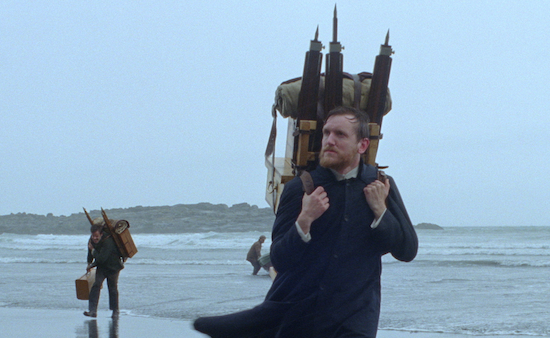In Hlynur Pálmason’s visually rich, religiously potent Godland, the landscapes of Iceland are not just captured for aesthetic value. The director/writer utilises the natural world of his homeland – the looming mountains, widening vistas, and wind-battered terrain – to draw out the screenplay’s rich themes of religion, existentialism, and human suffering. Notions of colonialism are also present in this densely layered work. In a similar way to Pálmason’s previous film A White, White Day (2019), humans become microscopic in comparison to their surroundings, physically and metaphorically. Godland is a visually resplendent work, powered by stunning cinematography by Maria von Hausswolff that bursts with symbolism. Where Pálmason’s 2019 film focussed solely on the process of grief, Godland undulates gracefully across a variety of ever-deepening levels, with the natural surroundings as important a component to its story as the characters.
Lucas (Elliott Crosset Hove), a Lutheran priest from Denmark living in the late nineteenth century, is sent to Iceland to set up a new parish church. At this time, Iceland is a remote Danish territory. Lucas’ rigorous and arduous trek across the intense, unforgiving landscapes of this Nordic country alongside his friend, Icelandic labourers, and a guide called Ragnar (Ingvar Sigurðsson) sets forth the compelling events of the plot. At first, Lucas is hopeful and excited for his journey ahead; in his eyes, this is an adventure to discover a new land and spread the word of God. His naive outlook proves to be the perfect breeding ground for his subsequent inner turmoil.
In one of Godland’s earliest shots, a boat transporting Lucas and his companions bobs fitfully, harshly, on violent waves indicating the forthcoming struggle. Pálmason and von Hausswolff amplify this unease, holding the shot of the boat for an extended period, moving the camera in unison with the sickness-inducing sway. When Lucas first sets foot on the Icelandic coastline, Pálmason shows only his reaction as opposed to what he is seeing, capturing his first, baby-like stumbles on the wet sand and inquisitive looks at what is before him. Throughout the film, the horizon becomes both a utopian dream and a stern warning for Lucas and the other colonisers.
As Lucas’ difficult journey continues and his crisis of faith worsens, Pálmason consistently focusses on the priest’s furtive glances to the horizon. Inviting sunrises and blue skies hint at possible religious reaffirmation for the priest, whilst burning red suns and harsh hues reflect his worsening lack of clarity. When Lucas’ close friend dies – effectively his only confidante on the journey – he further questions his place in the world. His physical and mental suffering is so cavernously deep, he wonders if a divine being actually exists. How can a kind God allow this to happen? His Lutheran view of a perfect, sinless world and belief of being saved by God’s grace are frequently challenged by the natural world. Pálmason offers no firm answers in Lucas’ surroundings. They only present him with more questions.
Faced with death, Lucas’ existential suffering confronts the viewer. In A White, White Day, in which the main character is forced to deal with the death of his wife, similar feelings of worthlessness and a search for meaning are present. Furthermore, no character in Godland is given important stature, and is never held in higher regard than the natural world. Pálmason consistently utilises wide shots and inserts characters into the formidable landscapes, with the surroundings dwarfing people until they become microscopic, with long takes drawing out the intensity further. In A White, White Day, the protagonist’s intense suffering and existential crisis is enhanced by the all-consuming whites of the landscapes; Pálmason captures his house, for example, from far away, the mountains looming around it as snow batters its foundations.
These shots of houses are captured in time lapses, a technique also used in Godland. A late shot in this film is of an animal’s corpse, captured as it decomposes across the different seasons. Every living being’s place on this earth is consistently questioned by Pálmason and his characters; natural elements continue around us, but we all die, our remains decaying where we last rested our heads. Godland is a consistently evocative reflection on human existence, and as unforgiving as the natural world of Iceland is, it is also striking in its beauty. There is great danger to it, but Pálmason never depicts it as an enemy, only a natural, living organism that we must respectfully exist beside.
In addition to being a rich tapestry of religion and existentialism, the film is a fiercely potent portrayal of colonialism. It is here, perhaps, where the natural world of Iceland becomes a true character in its own right. Lucas is representative of Danish colonialism: he heads there with his own beliefs to bestow on natives; he sees this territory as an opportunity for himself, his fellow Danes and other Lutherans; he has a preconceived idea of what the Icelandic world and its inhabitants will be like. The Icelandic characters, such as Ragnar, are given great agency by Pálmason, but it is the natural world of the Nordic country that fights back most fiercely against Lucas.
Reflective of the revived ideal of Icelandic independence in the nineteenth century, the natural world of Godland orders Lucas to leave, even contributing to the death of his friend. Ragnar treats nature with respect, whilst the priest whimpers in its face. Pálmason’s rigorous and frequently symbolic depiction of the Icelandic landscapes contributes to this fear that Lucas feels, which feeds directly into his worsening relationship with Ragnar. As with Werner Herzog’s Aguirre, The Wrath Of God, the natural world is portrayed as not welcoming new visitors.
Godland was released this year


